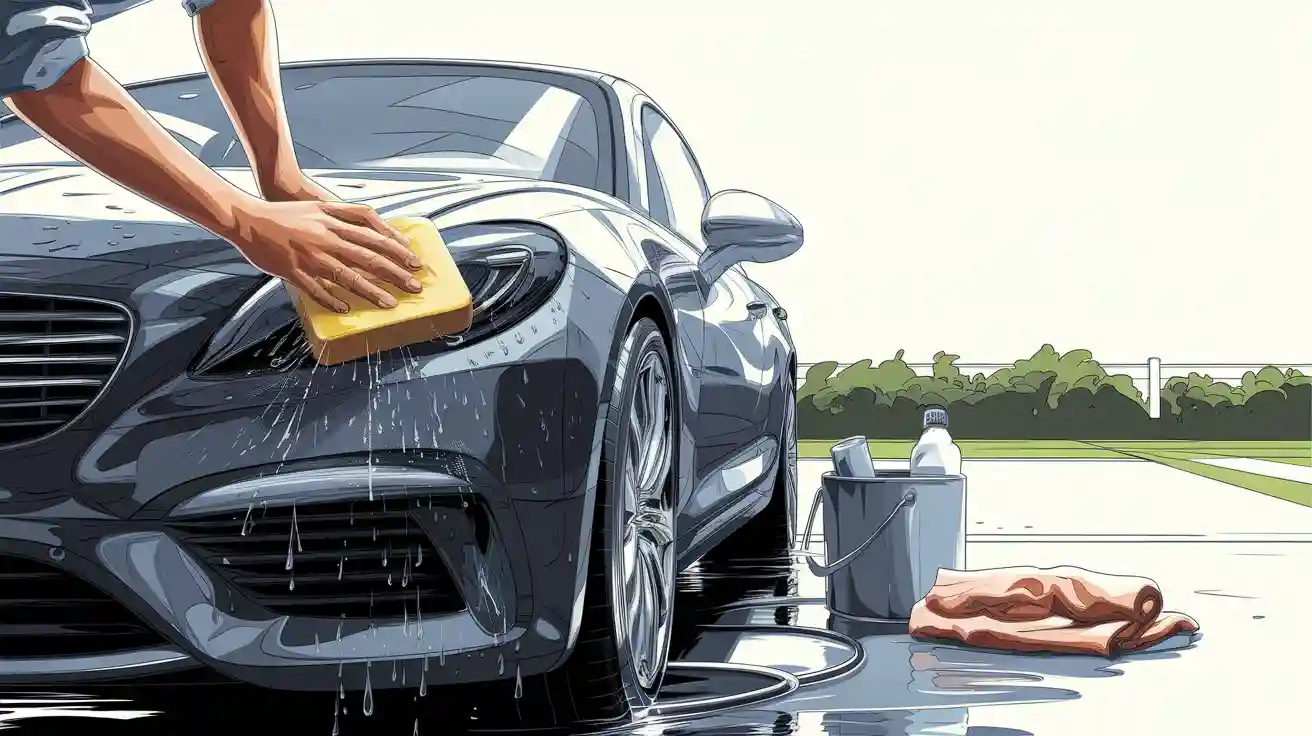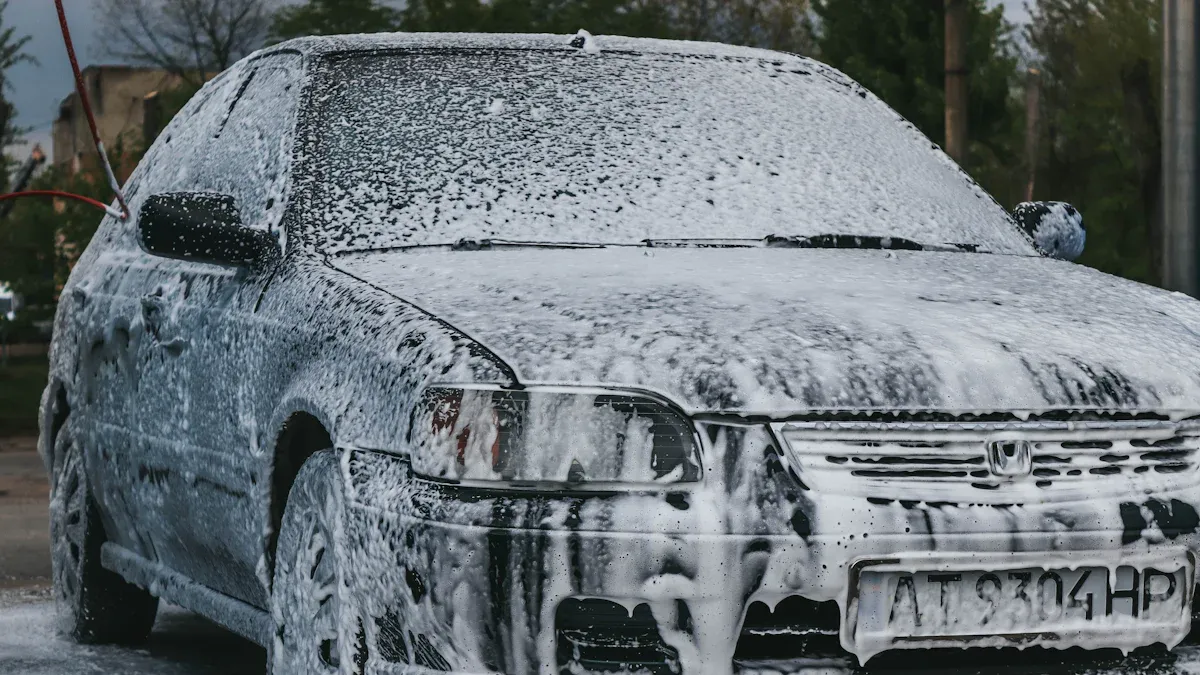
Most experts recommend washing your car every two weeks. If you’re asking, "how often should I wash my car?" the answer is about every two weeks to protect your car’s finish and keep it looking great. However, how often you wash your car can vary depending on the weather, where you drive, and where you park. On average, Americans wash their cars around 13 times a year, which is roughly every two weeks. Knowing how often should I wash my car is important because regular care helps your vehicle look good and last longer.
Statistic Description |
Data/Value |
|---|---|
Average car washes per year |
13 times (about 1-2 times per month) |
Water used per car wash |
About 38 gallons |
Percentage washing cars in winter |
32% (highest because of road salt) |
Percentage washing cars in spring/summer |
25% |
Percentage washing cars in fall |
18% (lowest) |
Key Takeaways
Wash your car every two weeks to protect its paint and keep it looking great.
Wash more often in harsh conditions like winter salt, pollen season, or dusty roads to prevent damage.
Never go longer than one month without washing to avoid rust and paint problems.
Adjust your washing routine based on weather, driving habits, and where you park your car.
Use gentle tools and car-safe soap to avoid scratches and protect your car’s finish.
How Often Should You Wash Your Car
General Rule: Every Two Weeks
Most experts agree that you should wash your car every two weeks. This frequency helps protect your car from dirt, grime, and environmental damage. Professional detailers and experienced car owners also recommend this schedule for daily-driven vehicles. When you stick to a two-week routine, you help keep your car’s paint in good shape and prevent buildup that can harm the finish. A study in Federal Way found that most people wash their cars about once every two weeks, which matches this expert advice. If you ask, "how often should I wash my car?" the answer is usually every other week for best results.
Tip: Setting a reminder on your phone can help you remember when it’s time to wash your car.
When to Wash More Often
Sometimes, you need to wash your car more often than every two weeks. If you live in a place with lots of road salt, pollen, or dust, you should increase your car wash frequency. Salt from winter roads can cause rust, while pollen and dust can stick to your car’s surface and damage the paint. If you drive on dirt roads or park under trees, sap and bird droppings can also harm your car’s finish. In these cases, frequent car washes help protect your vehicle and keep it looking clean.
Situation |
Recommended Frequency |
|---|---|
Winter (road salt) |
Every 1-2 weeks |
High pollen season |
Weekly |
Dusty or rural areas |
Weekly |
Parking under trees |
As soon as needed |
If you wonder, "how often should I wash my car" during harsh conditions, you may need to wash it every week or even more often.
Minimum Frequency: Once a Month
You should never go longer than a month without washing your vehicle. Washing your car at least once a month helps prevent long-term damage. Regularly washing your car removes dirt, salt, and other harmful substances that can cause rust and paint problems. Even if you do not drive much, a monthly car wash protects your car’s value and keeps it looking good.
Washing a car at least once a month is recommended to prevent long-term damage.
Regular car washes help avoid rust, especially important in areas with road salt.
Protecting the paint through washing prevents chipping and rust formation.
Maintaining a clean exterior helps preserve the vehicle’s resale value.
Regular washing can prolong the car’s lifespan by protecting it from damage.
Although car washes cost money, they can save money long-term by avoiding expensive repairs.
According to statistics, 66% of U.S. car owners wash their cars at least one to two times per month. This common practice shows that monthly washing is a smart way to avoid problems and keep your car in top shape. If you ask yourself, "how often should I wash my car?" remember that once a month is the minimum to prevent damage.
Factors That Affect Car Washing
Weather and Climate
Weather and climate play a big role in how often you need to wash your car. Sunny and warm days mean you drive more, so your car picks up more dirt, bug splats, and water spots. Spring brings pollen and leftover grime from winter, which can stick to your car’s surface. Rain can sometimes rinse off light dust, but it often leaves behind water spots and streaks, especially if your car was already dirty. Cold winters create a special challenge. Road salt and grime build up fast, so you need to wash your car more often to prevent rust. High winds and dust storms can cover your car with debris, making a thorough wash necessary.
Impact on Car Washing Needs |
|
|---|---|
Sunny and Warm |
More dirt, bugs, and water spots; need for drying |
Spring |
Pollen and winter grime; more frequent washes |
Rainy |
Water spots and streaks after rain |
Cold and Winter |
Salt and grime buildup; wash more to minimize rust |
High Winds and Dust |
Dust and debris; need for extra cleaning |
Tip: If you live near the ocean or in a snowy area, wash your car more often to protect it from salt.
Driving and Storage
How you drive and where you keep your car also affect washing your vehicle. If you drive on dusty or gravel roads, your car will get dirty faster. Parking under trees exposes your car to sap and bird droppings, which can damage the paint. Cars stored in garages or under covers stay cleaner longer. Indoor parking shields your car from road grime, UV rays, and acid rain. You may only need to wash a garage-kept car every two months. Outdoor parking means your car faces more dirt, bugs, and weather, so you need to wash it more often to keep it looking good.
Frequent driving on dirt roads increases washing needs.
Garage parking reduces wash frequency.
Outdoor parking exposes your car to more contaminants.
Local Contaminants
Local contaminants can make a big difference in your car washing routine. Salt from winter roads or ocean spray can stick to your car and cause damage. Washing your vehicle often helps prevent rust and keeps the paint in good shape. Pollen, tree sap, and bird droppings can also harm your car’s finish if left too long. If you live near busy roads or in industrial areas, your car may collect more grime and pollutants. Regular washing removes these harmful substances and helps your car last longer.
Salt spray in coastal areas speeds up oxidation.
Road salt in winter can damage your car’s undercarriage.
Pollen and sap need quick removal to protect paint.
Living near highways or factories means more frequent washes.
Seasonal Car Wash Tips

Summer Car Washing
Summer brings strong sunlight, high temperatures, and more dust. You need to protect your car’s paint and interior from the sun. Wash your car often to remove bug splats, tree sap, and dust. Use a pH-balanced shampoo and a microfiber mitt to avoid scratching the paint. Apply a UV protectant to the paint, tires, and trim. This helps prevent fading and cracking. Park in the shade when possible. Use sunshades inside your car to keep the dashboard and seats from getting too hot. Clean the interior with UV-blocking products to stop cracking and fading. Try to wash your car in the early morning or evening to avoid water spots from the hot sun.
Tip: Use a detailing clay bar after washing to remove stuck-on dirt and keep the paint smooth.
Winter Car Wash
Winter is tough on cars because of salt, snow, and grime. Salt can cause rust if you leave it on your car. Wash your car more often in winter, especially after snow or when roads are salty. Focus on cleaning the undercarriage with a hose or pressure washer. This removes salt and helps prevent rust. Apply wax or a sealant before winter starts. This adds a layer of protection against salt and moisture. After each wash, check for any signs of rust or damage. Schedule a full cleaning and maintenance check before winter begins.
Wash after every snowstorm or when you see salt buildup.
Use warm water if possible to help remove grime.
Apply rust-proofing oil to the undercarriage.
Coastal and Rural Areas
Living near the ocean or in the countryside brings special challenges. Ocean air contains salt, which can speed up rust. Rural areas have more dust, mud, and bugs. Wash your car more often if you live in these places. Pay extra attention to the undercarriage and wheel wells. Remove mud, salt, and debris quickly. Use a sealant to protect the paint from salt and dirt. In spring and summer, watch for pollen and bugs. Clean them off right away to avoid damage.
Wash weekly in coastal areas to remove salt spray.
Clean off mud and bugs as soon as you can in rural areas.
Use a protective wax or sealant every few months.
Risks of Overwashing and Underwashing

Damage from Too Much Car Washing
Washing your car often keeps it clean, but washing too much can cause problems. If you wash your car every few days, you might wear down the paint and clear coat. Using harsh brushes or dirty sponges can scratch the surface. Over time, these small scratches add up and make your car look dull. Automatic car washes with stiff bristles can also leave swirl marks. If you use strong soaps too often, you may strip away wax and protective coatings. This makes it harder to protect the paint from sun, rain, and dirt.
Tip: Always use a soft microfiber mitt and gentle, car-safe soap. Rinse your mitt often to avoid rubbing dirt into the paint.
You do not need to wash your car every day. A regular schedule, like every two weeks, keeps your car in good condition without causing damage.
Problems from Not Washing Enough
If you do not wash your car often enough, dirt and grime build up on the surface. This buildup can cause many problems:
Dirt, dust, and bird droppings stick to the paint and become hard to remove.
Road salt and pollution can eat away at the metal and cause rust.
Tree sap and acid rain damage the finish and make your car look old.
Dirt around windows, mirrors, and lights can block your view and make driving unsafe.
Grime around trim and seals can cause cracking and leaks.
When you skip washes, these contaminants can damage the paint and lead to corrosion. Regular washing helps prevent rust and keeps your car looking new. Clean cars also hold their value better. Industry reports show that a clean car can sell for up to 15% more than a dirty one. If you want to protect the paint and keep your car in good condition, stick to a regular washing routine.
Car Wash and Maintenance Routine
How Often Should I Wash My Car
You might wonder how often should I wash my car to keep it looking its best. Most experts suggest washing your car every two weeks. This schedule helps remove dirt, salt, and other harmful substances before they can damage the paint. If you drive in harsh conditions, you may need to wash your car more often. A regular car wash schedule also helps you spot problems early, like scratches or rust. When you follow a routine, you protect your car’s value and make each wash easier.
Tip: Try to wash your car after heavy rain, snow, or long trips on dusty roads.
A good car wash routine also includes checking the engine area. Clean the engine only when you see dirt or leaks. Use a soft rag and warm, soapy water. Avoid high-pressure water, which can cause engine problems.
Waxing and Detailing Schedule
Waxing your car every three months gives the paint a strong shield. Experts say this layer works like sunscreen, blocking UV rays and stopping dirt, sap, and salt from sticking. Waxing your car also makes it shine and keeps it easier to clean. Some waxes last up to six months, but most need reapplying every three months for the best results. You can test if your car needs wax by checking if water beads on the surface.
Detailing goes beyond washing and waxing. You should detail your car two to four times a year. This process cleans every part, inside and out, and helps keep your car in top shape.
Car Wash Steps
Follow these steps for the best way to wash your car:
Rinse the whole car with water to remove loose dirt.
Use a microfiber mitt soaked in soapy water. Start at the roof and work down.
Wash in straight lines, not circles, to avoid swirl marks.
Rinse the mitt often in clean water.
Rinse each section right after washing it.
Dry the car with clean microfiber towels to prevent water spots.
Note: Use separate mitts for the lower, dirtier parts of your car.
A smart car wash routine saves time and money. Many car washes aim for less than 2% downtime each month by doing regular maintenance. They also track water use and wash times to stay eco-friendly and efficient.
You should wash your car every two weeks to protect its appearance and keep it in top shape. Adjust your routine based on your local weather and driving habits. Regular washing helps your car last longer and keeps its appearance fresh. Create a schedule that works for you and your environment.
Take action today. Start a car care routine and enjoy a clean, shiny ride every day!
FAQ
How do I know if my car needs a wash sooner than two weeks?
Look for dirt, bird droppings, or salt on your car’s surface. If you see these, wash your car right away. Clean cars last longer and look better.
Can I wash my car too often?
You can wash your car often, but use gentle tools and car-safe soap. Avoid harsh brushes. Washing every few days is not needed for most cars.
Is it safe to use dish soap to wash my car?
You should not use dish soap. Dish soap can strip wax and damage your car’s paint. Always use a soap made for cars.
What is the best time of day to wash my car?
Wash your car in the early morning or evening. The sun can dry soap and water too fast, leaving spots. Shade helps you get better results.








0 comments